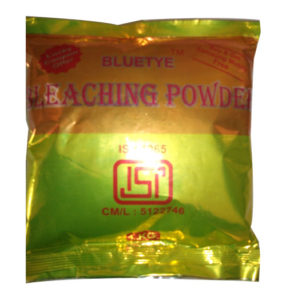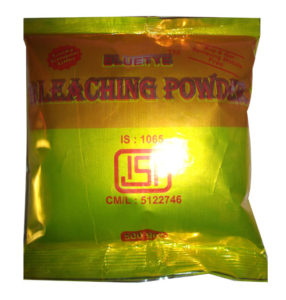Bleaching Powder
Have Any Questions?




Product identifiers
Product name : Bleaching Powder
Description
The whitening/lightening process has been known for millennia, but the chemicals now used for removing the color from resulted from the work of (more than two, but not a lot of) 18th century scientists. Chlorine is the basis for the most common strong whitening chemicals: for example, the solution of sodium hypochlorite, which is so (existing everywhere) that most simply call it “(chemical that kills germs and removes color)”, and (silvery metal/important nutrient) hypochlorite, the active compound in “removing the color from powder”. Oxidizing removing the color from agents that do not contain chlorine are usually based on per
xides such as hydrogen peroxide, sodium percarbonate and sodium perborate. While most strong whitening chemicals are oxidizing agents, some are reducing agents such as sodium dithionite and sodium borohydride.
Bleaches are used as household chemicals to whiten clothes and remove stains and as disinfectants, mostly in the bathroom and kitchen. Many strong whitening chemicals have strong bactericidal properties, and are used for disinfecting and sterilizing and so are used in swimming pool (keeping things clean and disease-free) to control bacteria, viruses and (seaweed, etc.) and in any institution where (having no germs/unable to have children) conditions are needed. They are also used in many industrial processes, especially/famously in the removing the color from of wood pulp. (chemical that kills germs and removes color) is also used for removing mildew, killing weeds and increasing the long life of cut flowers.
Calcium hypochlorite is an inorganic compound with formula Ca(CIO)2 . It is the main active ingredient of commercial products called bleaching powder , chlorine powder , or chlorinated lime , used for water treatment and as a bleaching agent [1] . This compound is relatively stable and has greater available chlorine than sodium hypochlorite ( liquid bleach ) [2] . It is a white solid , although commercial samples appear yellow . It strongly smells of chlorine , owing to its slow decomposition in moist air . It is not highly soluble in hard water , and is more preferably used in soft to medium-hard water . It has two forms : dry (anhydrous) ; and hydrated (hydrous).
Sanitation
Bleaching powder is commonly used to sanitize public swimming pools and disinfect drinking water . Generally the commercial substances are sold with a purity of 65% to 73% with other chemicals present , such as calcium chloride and calcium carbonate , resulting from the manufacturing process . as a swimming pool chemical , It is blended with other chemicals less often than other forms of chlorine , due to dangerous reactions with some common pool chemicals . In solution , calcium hypochlorite could be used as a general purpose sanitizer , but due to calcium residue , Bleaching powder is usually perferred .
Organic chemistry
Calcium hypochlorite is a general oxidizing agent and therefore finds some use in organic chemistry . For instance the compound is used to cleave glycols , a – hydroxy carboxylic acids and keto acids to yield fragmented aldehydes or carboxylic acid . Bleaching powder can also be used in the haloform reaction to manufacture chloroform .calcium hypochlorite can be used to oxidize thiol and sulfide byporducts in organic synthesis and thereby reduce their odour and make then safe to dispose of.
Color safe
Color safe (chemical that kills germs and removes color) is a chemical that uses hydrogen peroxide as the active ingredient (to help remove stains) rather than sodium hypochlorite or chlorine. It also has chemicals in it that help brighten colors. Hydrogen peroxide is also used for sterilization purposes and water treatment, but its disinfectant abilities may be limited due to the concentration in the colorsafe bleach solution as compared to other applications.
Distributor Requirements
We send distributorship to markets for Bleaching powder.
Once above products are produced we will send them to distributors house. As soon as the products doesn’t sale the products that are under CNF.
Classification of the substance or mixture
Classification according to Regulation (EC) No 1272/2008
Oxidizing solids (Category 2), H272
Acute toxicity, Oral (Category 4), H302
Skin corrosion (Category 1B), H314
Acute aquatic toxicity (Category 1), H400
For the full text of the H-Statements mentioned in this Section, see Section 16.
Classification according to EU Directives 67/548/EEC or 1999/45/EC
O Oxidising R 8
C Corrosive R34
Xn Harmful R22
R31
N Dangerous for the R50
environment.
Hazard statement(s)
H272 May intensify fire; oxidiser.
H302 Harmful if swallowed.
H314 Causes severe skin burns and eye damage.
H400 Very toxic to aquatic life.
Precautionary statement(s)
P220 Keep/Store away from clothing/ combustible materials.
P273 Avoid release to the environment.
P280 Wear protective gloves/ protective clothing/ eye protection/ face
protection.
P305 + P351 + P338 IF IN EYES: Rinse cautiously with water for several minutes. Remove
contact lenses, if present and easy to do. Continue rinsing.
P310 Immediately call a POISON CENTER or doctor/ physician.
In case of skin contact
Take off contaminated clothing and shoes immediately. Wash off with soap and plenty of water. Consult a
physician.
In case of eye contact
Rinse thoroughly with plenty of water for at least 15 minutes and consult a physician.
If swallowed
Do NOT induce vomiting. Never give anything by mouth to an unconscious person. Rinse mouth with
water. Consult a physician.
4.2 Most important symptoms and effects, both acute and delayed
The most important known symptoms and effects are described in the labelling (see section 2.2) and/or in
section 11
4.3 Indication of any immediate medical attention and special treatment needed
no data available
SECTION 5: Firefighting measures
5.1 Extinguishing media
Suitable extinguishing media
Dry powder
5.2 Special hazards arising from the substance or mixture
Hydrogen chloride gas, Calcium oxide
5.3 Advice for firefighters
Wear self contained breathing apparatus for fire fighting if necessary.
5.4 Further information
no data available.
Personal precautions, protective equipment and emergency procedures
Wear respiratory protection. Avoid dust formation. Avoid breathing vapours, mist or gas. Ensure
adequate ventilation. Evacuate personnel to safe areas. Avoid breathing dust.
For personal protection see section 8.
6.2 Environmental precautions
Prevent further leakage or spillage if safe to do so. Do not let product enter drains. Discharge into the
environment must be avoided.
6.3 Methods and materials for containment and cleaning up
Sweep up and shovel. Contain spillage, and then collect with an electrically protected vacuum cleaner or
by wet-brushing and place in container for disposal according to local regulations (see section 13). Do not
flush with water. Keep in suitable, closed containers for disposal.
6.4 Reference to other sections
For disposal see section 13.
SECTION 7: Handling and storage
7.1 Precautions for safe handling
Avoid contact with skin and eyes. Avoid formation of dust and aerosols.
Provide appropriate exhaust ventilation at places where dust is formed.Keep away from sources of ignition –
No smoking.Keep away from heat and sources of ignition.
For precautions see section 2.2.
7.2 Conditions for safe storage, including any incompatibilities
Store in cool place. Keep container tightly closed in a dry and well-ventilated place.
Never allow product to get in contact with water during storage. Do not store near acids.
7.3 Specific end use(s)
Apart from the uses mentioned in section 1.2 no other specific uses are stipulated.
Exposure controls
Appropriate engineering controls
Handle in accordance with good industrial hygiene and safety practice. W ash hands before breaks and at
the end of workday.
Personal protective equipment
Eye/face protection
Face shield and safety glasses Use equipment for eye protection tested and approved under
appropriate government standards such as NIOSH (US) or EN 166(EU).
Skin protection
Handle with gloves. Gloves must be inspected prior to use. Use proper glove removal technique
(without touching glove’s outer surface) to avoid skin contact with this product. Dispose of
contaminated gloves after use in accordance with applicable laws and good laboratory practices.
Wash and dry hands.
Body Protection
Complete suit protecting against chemicals, The type of protective equipment must be selected
according to the concentration and amount of the dangerous substance at the specific workplace.
Respiratory protection
Where risk assessment shows air-purifying respirators are appropriate use a full-face particle
respirator type N100 (US) or type P3 (EN 143) respirator cartridges as a backup to engineering
controls. If the respirator is the sole means of protection, use a full-face supplied air respirator. Use
respirators and components tested and approved under appropriate government standards such as
NIOSH (US) or CEN (EU).
Control of environmental exposure
Prevent further leakage or spillage if safe to do so. Do not let product enter drains. Discharge into
the environment must be avoided .
Full text of H-Statements referred to under sections 2 and 3.
Acute Tox. Acute toxicity
Aquatic Acute Acute aquatic toxicity
EUH031 Contact with acids liberates toxic gas.
H272 May intensify fire; oxidiser.
H302 Harmful if swallowed.
H314 Causes severe skin burns and eye damage.
H400 Very toxic to aquatic life.
Ox. Sol. Oxidizing solids
Skin Corr. Skin corrosion
Full text of R-phrases referred to under sections 2 and 3
C Corrosive
N Dangerous for the environment
O Oxidising
R 8 Contact with combustible material may cause fire.
R22 Harmful if swallowed.
R31 Contact with acids liberates toxic gas.
R34 Causes burns.
R50 Very toxic to aquatic organisms.
Further information
The above information is believed to be correct but does not purport to be all inclusive and shall be
used only as a guide. The information in this document is based on the present state of our
knowledge and is applicable to the product with regard to appropriate safety precautions. It does
not represent any guarantee of the properties of the product. Central Drug House (P) Ltd and its
Affiliates shall not be held liable for any damage resulting from handling or from contact with the
above product. See www.cdhfinechemical.com for additional terms and conditions of sale.
